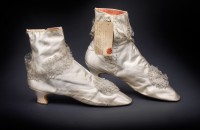 A pair of white silk ankle boots worn by the Empress Elisabeth of Austria, also known as Sisi, was acquired at auction by the Sisi Museum in Vienna’s Hofburg Palace. Bidding at the auction, held by the Dorotheum auction house in Vienna on May 7th, 2015, was so fierce that the shoes, estimated to sell for $9,200 – 16,000 wound up costing the museum $86,000. The shoes were worn only once by the Empress and were given to one of her chambermaids in April of 1899 when Elisabeth’s closets were cleaned out after her death.
A pair of white silk ankle boots worn by the Empress Elisabeth of Austria, also known as Sisi, was acquired at auction by the Sisi Museum in Vienna’s Hofburg Palace. Bidding at the auction, held by the Dorotheum auction house in Vienna on May 7th, 2015, was so fierce that the shoes, estimated to sell for $9,200 – 16,000 wound up costing the museum $86,000. The shoes were worn only once by the Empress and were given to one of her chambermaids in April of 1899 when Elisabeth’s closets were cleaned out after her death.
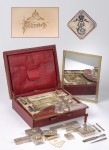 Other Sisi-related items sold far higher than expected. A beautiful red morocco leather travel writing and sewing box given to Elisabeth when she was an 11 years old Bavarian princess, just five years before she would marry her cousin Emperor Franz Joseph I of Austria, was estimated to sell for $11,500 – 23,000, but a furious bidding war erupted over this piece too. In the end it went to a phone bidder who paid $86,000 for it. In a fitting bookend to her life, Sisi’s death certificate issued in Geneva on September 13th, 1898, three days after her assassination by Italian anarchist Luigi Lucheni, sold for $17,500, 15 times the low estimate of $1,150.
Other Sisi-related items sold far higher than expected. A beautiful red morocco leather travel writing and sewing box given to Elisabeth when she was an 11 years old Bavarian princess, just five years before she would marry her cousin Emperor Franz Joseph I of Austria, was estimated to sell for $11,500 – 23,000, but a furious bidding war erupted over this piece too. In the end it went to a phone bidder who paid $86,000 for it. In a fitting bookend to her life, Sisi’s death certificate issued in Geneva on September 13th, 1898, three days after her assassination by Italian anarchist Luigi Lucheni, sold for $17,500, 15 times the low estimate of $1,150.
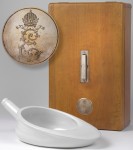 On the other hand, her personal traveling chamber pot, a lovely white glazed ceramic vessel along with its lockable wooden doeskin-lined travel box engraved with her monogram and the Austrian imperial crown, went for a comparatively modest $5,800, on the low end of the pre-sale estimate of $4,600 – 9,200. I hope the museum bought it because it’s such an incredibly intimate object it belongs in their permanent collection of her belongings.
On the other hand, her personal traveling chamber pot, a lovely white glazed ceramic vessel along with its lockable wooden doeskin-lined travel box engraved with her monogram and the Austrian imperial crown, went for a comparatively modest $5,800, on the low end of the pre-sale estimate of $4,600 – 9,200. I hope the museum bought it because it’s such an incredibly intimate object it belongs in their permanent collection of her belongings.
The Sisi Museum inhabits rooms in the Hofburg Palace that were once the empress’ suite. The objects on display tell the story of her life, starting with her unusually unstructured youth in Bavaria where her circus-loving father avoided the restrictions and formalities of court in favor of his country estate of Possenhofen where the family lived an outdoorsy, free-spirited life of horseback riding and travel. A shy, timorous girl, she was ill-prepared for the exigencies of her new role when she wed the 23-year-old emperor. The rigidity of the imperial court was a heavy burden on her. Pressured by her formidable mother-in-law/aunt Princess Sophie of Bavaria to produce the male heir, Sissy had three children in three years until her son Rudolf was born. All three of these children were removed from her care immediately after their birth; Princess Sophie raised them, not their mother.
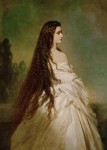 Elisabeth had numerous health problems — coughing, insomnia, anemia — exacerbated by what today we would likely consider disordered eating. She was obsessed with maintaining her slim figure, fasting and dieting to ensure her weight never went past 50 kg (110 lb), a very low figure considering she was 5’8″. She exercised assiduously, converting the Knight’s Hall of the Hofburg into a gymnasium and riding horses and walking for hours at a time. Her profound dislike of court life played a role in her illness as well. When she traveled to spas to take the cure, or to Corfu or to Madeira, her symptoms quickly disappeared only to return with a vengeance as soon as she neared Vienna.
Elisabeth had numerous health problems — coughing, insomnia, anemia — exacerbated by what today we would likely consider disordered eating. She was obsessed with maintaining her slim figure, fasting and dieting to ensure her weight never went past 50 kg (110 lb), a very low figure considering she was 5’8″. She exercised assiduously, converting the Knight’s Hall of the Hofburg into a gymnasium and riding horses and walking for hours at a time. Her profound dislike of court life played a role in her illness as well. When she traveled to spas to take the cure, or to Corfu or to Madeira, her symptoms quickly disappeared only to return with a vengeance as soon as she neared Vienna.
Considered one of the most beautiful women in Europe, Sisi spent hours a day on her beauty regimen. Her ankle-length hair took two to three hours a day to arrange. She used all kinds of nostrums and creams to preserve her youthful good looks. Here’s a tip for you from Empress Elisabeth: wear a pounded filet of raw veal on your face underneath a leather mask. Keeps the skin supple, donchaknow.
 As she got older and most self-assured, she spent more and more time away from court, traveling and avoiding imperial duties as much as possible. She also avoided politics, only getting involved in Franz Joseph’s decision-making once but to great effect. She was a very vocal advocate for the recognition of Hungary’s political rights and played a significant role in persuading her reactionary husband to agree to the Compromise of 1866 which established the Austro-Hungarian Empire. Franz Joseph and Elisabeth were crowned King and Queen of Hungary in 1867. The next year Sisi gave birth to their last child, the Archduchess Marie-Valerie. The timing was generally believed not to have been a coincidence, ie, she let Franz Joseph into the bed she’d spent a decade keeping him out of as a reward for the Compromise.
As she got older and most self-assured, she spent more and more time away from court, traveling and avoiding imperial duties as much as possible. She also avoided politics, only getting involved in Franz Joseph’s decision-making once but to great effect. She was a very vocal advocate for the recognition of Hungary’s political rights and played a significant role in persuading her reactionary husband to agree to the Compromise of 1866 which established the Austro-Hungarian Empire. Franz Joseph and Elisabeth were crowned King and Queen of Hungary in 1867. The next year Sisi gave birth to their last child, the Archduchess Marie-Valerie. The timing was generally believed not to have been a coincidence, ie, she let Franz Joseph into the bed she’d spent a decade keeping him out of as a reward for the Compromise.
It was a one-time deal. The imperial couple grew increasingly estranged as Sisi continued to travel on her own and avoid the settled domesticity (albeit a massively glamorous version) of life in Vienna that her husband wanted. When their only son Rudolf killed himself in his hunting lodge at Mayerling in 1889 after the death of his 17-year-old mistress Baroness Mary Vetsera (we don’t know how she died; it could have been a murder-suicide but the authorities covered everything up and modern examinations of her bones have been inconclusive), Franz Joseph and Elisabeth’s marriage splintered irrevocably. They lived separate lived from then on, although their later letters indicate they eventually developed a genuine friendship.
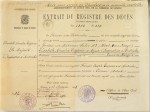 Ten years later, Sisi was visiting Geneva under an assumed name. She had refused police protection and dismissed her attendants when Luigi Lucheni, aware of who she really was thanks to the newspaper headlines identifying the “Countess of Hohenembs” as the empress, stabbed her in the heart with a sharpened file. Her tight corset slowed her blood loss enough to keep her alive for a few hours before her pericardium filled with blood and her heart stopped beating. Franz Joseph, who had been madly in love with her since she was 15, was devastated by her death. While she had received relatively little press coverage and public attention in the empire during her increasingly withdrawn life, after her death the legend of the beautiful but miserable queen, the open-hearted innocent stifled by imperial etiquette but beloved by the people, sprang into being. A trilogy of films in the 1950s starring Romy Schneider as Elisabeth sealed that image in the modern imagination.
Ten years later, Sisi was visiting Geneva under an assumed name. She had refused police protection and dismissed her attendants when Luigi Lucheni, aware of who she really was thanks to the newspaper headlines identifying the “Countess of Hohenembs” as the empress, stabbed her in the heart with a sharpened file. Her tight corset slowed her blood loss enough to keep her alive for a few hours before her pericardium filled with blood and her heart stopped beating. Franz Joseph, who had been madly in love with her since she was 15, was devastated by her death. While she had received relatively little press coverage and public attention in the empire during her increasingly withdrawn life, after her death the legend of the beautiful but miserable queen, the open-hearted innocent stifled by imperial etiquette but beloved by the people, sprang into being. A trilogy of films in the 1950s starring Romy Schneider as Elisabeth sealed that image in the modern imagination.